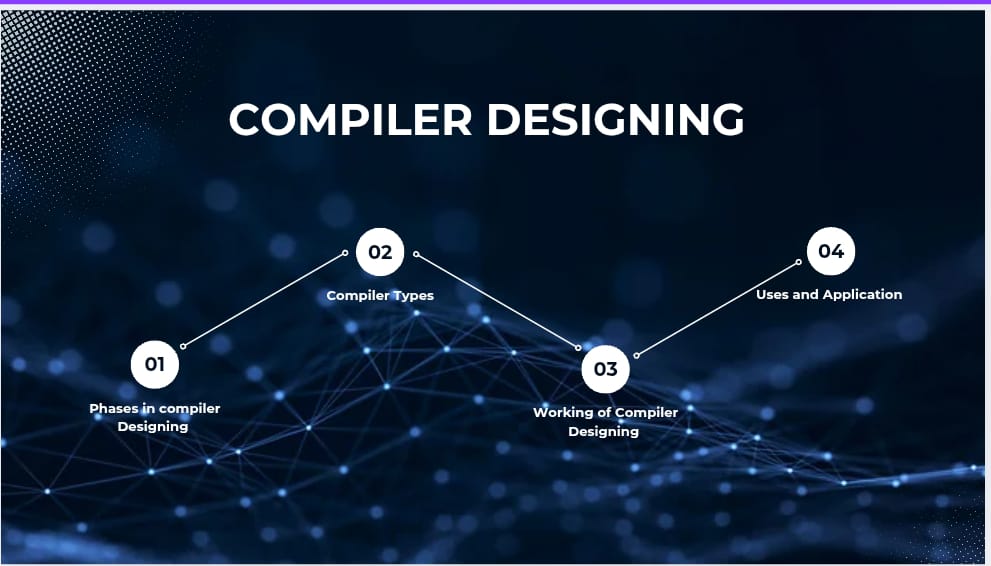Compiler Design: An In-Depth Guide
Introduction to Compiler Design
A compiler is a software tool that translates high-level programming language code (like C, Java, or Python) into machine-readable code (binary or assembly language). Compiler design is the process of creating such a compiler, ensuring efficiency, accuracy, and optimization in code translation.
Compilers play a crucial role in software development, enabling programmers to write code in human-readable languages while ensuring that computers can execute it efficiently. Without compilers, programmers would have to write programs directly in machine code, which is tedious and error-prone.
What is Compiler Design?
Compiler design involves the study and implementation of algorithms and techniques to convert source code into executable code. It includes:
- Lexical Analysis (breaking code into tokens)
- Syntax Analysis (parsing the structure)
- Semantic Analysis (checking meaning and correctness)
- Intermediate Code Generation (creating an abstract representation)
- Optimization (improving performance)
- Code Generation (producing machine code)
Example:
When you write a C program like:
#include <stdio.h> int main() { printf("Hello, World!"); return 0; }
The compiler converts this into binary instructions that the CPU can execute.
Types of Compilers
Compilers can be classified into several types based on their functionality and usage:
1. Single-Pass Compiler
- Reads the source code only once.
- Faster but less optimized.
- Example: Early Pascal compilers.
2. Multi-Pass Compiler
- Scans the source code multiple times.
- Allows better optimization.
- Example: Modern C++ compilers (GCC, Clang).
3. Just-In-Time (JIT) Compiler
- Compiles code at runtime (used in Java, .NET).
- Balances interpretation and compilation.
- Example: Java Virtual Machine (JVM).
4. Cross Compiler
- Used in embedded systems development.
- Example: Compiling ARM code on an x86 machine.
5. Source-to-Source Compiler (Transpiler)
- Converts one high-level language to another.
- Example: TypeScript to JavaScript compiler.
6. Optimizing Compiler
- Enhances performance by reducing execution time and memory usage.
- Example: LLVM, Intel C++ Compiler.
Phases of Compiler Design
A compiler works in multiple phases, divided into two major parts:
1. Analysis Phase (Frontend)
a) Lexical Analysis (Scanner)
- Breaks source code into tokens (keywords, identifiers, operators).
- Example:
int x = 10;→ Tokens:int,x,=,10,;
b) Syntax Analysis (Parser)
- Checks grammar using parse trees or abstract syntax trees (AST).
- Detects syntax errors (missing semicolons, mismatched brackets).
c) Semantic Analysis
- Ensures logical correctness (type checking, scope resolution).
- Example:
int x = "hii"; // Error: types
2. Synthesis Phase (Backend)
d) Intermediate Code Generation
- Produces platform-independent code (e.g., Three-Address Code).
- Example:
t1 = 10 x = t1
e) Code Optimization
- Improves performance by removing redundant code.
- Example:
x = 10 + 5; // Optimized to → x = 15;
f) Code Generation
- Converts intermediate code into machine code.
- Example:
MOV R1, #10 STORE x, R1
How a Compiler Works (Step-by-Step Process)
- Input: High-level source code (e.g., C program).
- Lexical Analysis: Splits code into tokens.
- Syntax Analysis: Checks grammar using parsing.
- Semantic Analysis: Validates logic and types.
- Intermediate Code: Generates abstract representation.
- Optimization: Enhances efficiency.
- Code Generation: Produces executable machine code.
- Output: Binary file (e.g.,
.exe,.o).
Example Workflow:
For the code:
int sum(int a, int b) { return a + b; }
- Lexer: Identifies
int,sum,(,a,,,b,),{,return,+,}. - Parser: Builds AST showing function structure.
- Semantic Checker: Ensures
aandbare integers. - Intermediate Code:
t1 = a + b return t1
- Optimizer: Simplifies if possible.
- Code Generator: Produces assembly like:
ADD R1, R2, R3 RET
Advantages of Compiler Design
- Efficiency: Compiled code runs faster than interpreted code.
- Optimization: Reduces execution time and memory usage.
- Error Detection: Catches syntax and semantic errors early.
- Portability: Intermediate code can run on different machines.
- Security: Harder to reverse-engineer than interpreted code.
Comparison with Interpreter
| Feature | Compiler | Interpreter |
|---|---|---|
| Execution Speed | Faster | Slower |
| Error Handling | After full compilation | Line-by-line |
| Optimization | High | Limited |
| Examples | GCC, Clang | Python, JavaScript |
Compiler Design in Machine Design and Its Relation with Regular Expressions
1. Introduction
Compiler design is not just about translating high-level code into machine language—it also plays a crucial role in machine design, particularly in hardware description, embedded systems, and digital logic synthesis. Additionally, regular expressions (regex) are fundamental in lexical analysis, a key phase of compiler design.
This section explores:
- How compiler design aids in machine design (CPU architecture, embedded systems, FPGA programming).
- The relationship between compiler design and regular expressions (lexical analysis, pattern matching).
2. Role of Compiler Design in Machine Design
2.1 Hardware Description Languages (HDLs) and Compilers
Modern machines (CPUs, GPUs, FPGAs) are designed using Hardware Description Languages (HDLs) like Verilog and VHDL. These languages describe digital circuits, and HDL compilers convert them into gate-level netlists or machine-executable configurations.
Example: FPGA Programming
- An FPGA (Field-Programmable Gate Array) is configured using an HDL.
- The HDL compiler (like Xilinx Vivado or Intel Quartus) converts Verilog/VHDL into:
- Synthesis: Logic gate optimization.
- Place & Route: Physical layout generation.
- Bitstream: Binary file for FPGA configuration.
Relation to Compiler Phases
| Compiler Phase | Equivalent in HDL Compilation |
|---|---|
| Lexical Analysis | Tokenizes Verilog keywords (module, wire, reg). |
| Syntax Analysis | Checks HDL grammar (e.g., missing endmodule). |
| Semantic Analysis | Ensures correct signal widths (wire [7:0] data). |
| Optimization | Removes redundant logic gates. |
| Code Generation | Produces FPGA bitstream or ASIC layout. |
2.2 Embedded Systems & Cross-Compilation
- Embedded devices (microcontrollers, IoT chips) require cross-compilers that run on a PC but generate machine code for ARM, AVR, or RISC-V.
- Example:
- Writing firmware in C → Compiled to ARM assembly → Flashed onto a Raspberry Pi.
2.3 CPU Design & Compiler Optimization
- Compilers help optimize Instruction Set Architectures (ISAs).
- Example:
- RISC-V compilers help test new CPU instructions.
- Loop unrolling (a compiler optimization) improves pipeline efficiency.
3. Relationship Between Compiler Design and Regular Expressions
3.1 Regular Expressions in Lexical Analysis
- The lexical analyzer (lexer) uses regex to identify tokens (keywords, identifiers, numbers).
- Example:
- Regex for an integer:
[0-9]+ - Regex for a variable:
[a-zA-Z_][a-zA-Z0-9_]*
- Regex for an integer:
How Lexer Uses Regex
- Pattern Matching:
if→ Keyword123→ Integer (matched by[0-9]+)x1→ Identifier (matched by[a-zA-Z_][a-zA-Z0-9_]*)
- Flex/Lex Tools:
- Tools like Flex (Fast Lexical Analyzer) use regex rules to generate a lexer.
Example Lexer Rule (Flex Syntax)
%%
[0-9]+ { printf("INTEGER: %s\n", yytext); }
"if" { printf("KEYWORD_IF\n"); }
[a-zA-Z_][a-zA-Z0-9_]* { printf("IDENTIFIER: %s\n", yytext); }
%%
3.2 Applications Beyond Lexing
- Text Processing in Compilers:
- Regex helps in macro expansion, preprocessing, and error detection.
- Code Optimization:
- Regex-based pattern matching can detect redundant loops or unused variables.
4. Practical Example: Compiler Techniques in Machine Design
Case Study: Designing a Custom CPU Instruction
- Define Instruction in HDL (Verilog):
module ALU (input [31:0] a, b, output [31:0] out); assign out = a + b; // Simple adder endmodule
- Compile with HDL Compiler:
- Converts Verilog → Optimized logic gates → FPGA bitstream.
- Write Assembly Code (Compiler-Generated):
ADD R1, R2, R3 ; Generated by compiler
- Link with Software (Cross-Compiler):
- A C compiler (like GCC) generates machine code for the custom CPU.
5. Advantages of This Integration
✅ Faster Hardware Development: HDL compilers automate circuit synthesis.
✅ Better Code Optimization: Compilers improve both software and hardware efficiency.
✅ Automated Lexical Analysis: Regex speeds up tokenization in compilers.
6. Conclusion
- Compiler design is essential in machine design, enabling HDL compilation, embedded systems, and CPU optimization.
- Regular expressions are crucial in lexical analysis, helping compilers tokenize source code efficiently.
- Together, they bridge software and hardware, making modern computing faster and more efficient.
Conclusion
Compiler design is a fundamental aspect of computer science that bridges human-readable code and machine execution. By understanding its phases, types, and working principles, developers can write efficient and optimized programs. Modern compilers like GCC, LLVM, and JIT compilers (like in Java) continue to evolve, enhancing performance and security in software development.
Whether you’re a student learning compiler theory or a developer optimizing code, mastering compiler design is essential for building efficient and reliable software systems.










